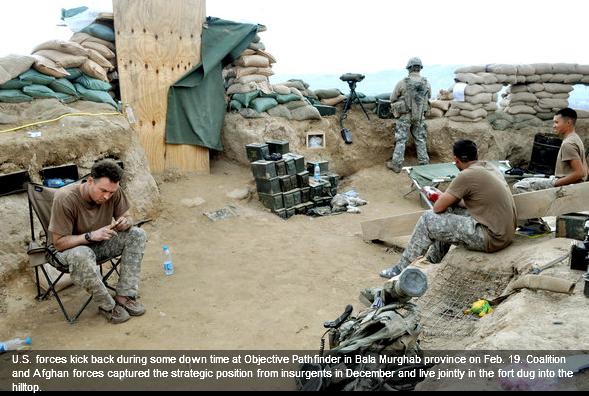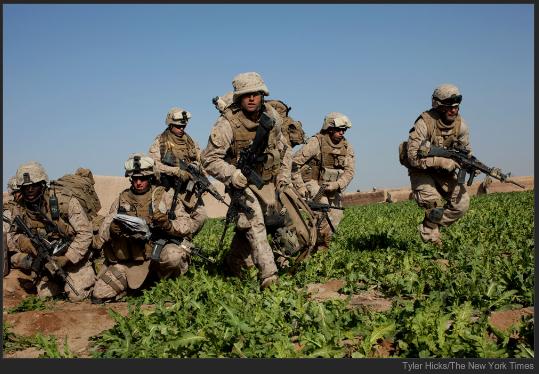Battlespace Control and Special Operations Forces in Afghanistan
BY Herschel SmithIn Reigning in SOF in Afghanistan I addressed the issue of General McChrystal having brought Special Operations Forces under his direct control in Afghanistan, or in other words, putting into place a structure that would ensure unity of command over all U.S. troops in Afghanistan. The ostensible reason given for this was continuing noncombatant casualties and the need to reduce them by making SOF accountable to someone directly inside Afghanistan.
I demurred, rehearsing the idea once again that the attempt completely to end noncombatant casualties had contributed to the unnecessary deaths of U.S. servicemen. Pristine, riskless war is a preening moralists dream and a warrior’s nightmare. But I did support the idea of organizing all troops under a singular command structure.
I support the consolidation of forces because SOF shouldn’t be operating out of the chain of command. If there is a direct action raid and a father or a son is killed in the middle of the night, the infantry (or those attached to the infantry, i.e., SOF) should have done it, under the direction of the immediate chain of command, and they should all be present the next morning to explain to the village why it happened. If you don’t harbor insurgents, this won’t happen. There is nothing like a little time with the villagers by those who did the killing … expending effort policing, teaching and admonishing.
But this isn’t the end of the story, and it appears that the reason given for the reorganization is mere cover. First, consider what the always interesting and knowledgeable Tim Lynch tells us about Marine Corps operations in the Helmand Province regarding their use of Special Operations Forces.
While the Marines handled the close fight around Marjah they used the varsity Special Operations assets to go deep. Getting those organizations to work for you in a subordinate role is not just hard; it is one of the most impressive accomplishments of the Marine deployment to date. I’ve known General Nicholson and the senior members of his operations staff all my adult life and this last accomplishment impresses me more than anything else they have done since arriving in Afghanistan. That’s how hard it is to get the big boys to play nice. One of the consistent complaints concerning the Joint Special Operations forces in Afghanistan is their penchant for running operations without informing or coordinating or even talking to the battle space commander responsible for the area they were working. Tim of Panjwai once got a call from the Canadian HQ in Kandahar back in the day when he was on active duty and in command of a company deployed deep inside the Panjwai district:
“Why are you currently fighting in the town of XXXX?” he was asked.
“Sir, I’m on my COP and were I not here and engaged in some sort of fight I assure you sir, that you would be the first to know.”
“Then who the hell is in XXXX wearing Canadian uniforms shooting the place up?”
It was the varsity SF guys running their own mission with their own assets for reasons known only to them. Tim and his troops had to deal with the mess they created after they were long gone. To this day they have no idea what went on or if the mission which cost them in lost credibility, lost cooperation, and the loss of hard earned good will was worth it.
The Marines made a deal last summer – which went something like this: “We want you guys operating in our AO and we will give you priority on our rotary wing, intelligence and fire support assets, but you have work with us integrating everything you do with our campaign plan.” It was not an easy sell and at first there was reluctance from the varsity to cooperate. But they gave it a shot, and they started chalking up success after success and nothing attracts more talent into the game like success. While the Marine snipers and their recon brothers have been bleeding the Taliban around Marjah, the varsity has been going deep and going deep often. All the big boys have joined the game now, the SAS, the SEAL’s, The Unit and other organizations who you have never heard of and never will hear about. It is true that killing lots of fighters is not that relevant in the COIN battle. Yet you still need to target and kill competent leaders along with any proficient logistic coordinators who pop up on the radar screen. The varsity SOF guys have been doing that for months.
The Marines handled SOF differently than does Army, Navy or Air Force. Unity of command is essential to the MEU (Marine Expeditionary Unit) and MAGTF (Marine Air-Ground Task Force) mission oriented approach. Having SOF in their battle space without knowing, approving and integrating their efforts into a unity of approach isn’t the Marine way. And given McChrystal’s appreciation for unity of command in Afghanistan, he surely approves.
Or does he? First, there was this comment on the Small Wars Journal blog (regarding this Washington Post article about Army complaints concerning Marines’ autonomy in Helmand).
The rumor is that the Commandant, Gen Conway, spoke to Gen Petraeus and McChrystal and asked them, “What are you not getting that you want?” In other words, if you want some other result, tell the Marines what you want and they will change course. But let us handle it our way. The problem is that McChrystal does not respect, appreciate, or want the MAGTF. He wants to use the Marines in piecemeal fashion in suppport of Army forces.
I heard it second hand. Someone should ask this question of the Commandant.
I followed up reading this comment with a letter to General McChrystal’s Public Affairs Officer, asking the following question(s).
I would like to pose a question for General McChrystal. If he would like to respond, I will post his response without any editorial comment, remarks or redaction. Here is the question:
As you are no doubt aware, there is apparently a push to exert more control over the Marine Corps operations in the Helmand province.
Furthermore, there are indications – however reliable or not – that the MAGTF concept (philosophy and organization structure) is under-appreciated.
But mission-based, strict Marine Corps chain of command philosophy is the cornerstone of the MEU and MAGTF approach, and it has redounded to significant successes wherever it has been implemented, from the Anbar Province to Helmand (and many engagements prior to those). Can you give us your perspective on the Marine Corps operations thus far in Helmand, and speak to the issues raised in the subject article?
Thank you.
This letter was written five days ago and to this date there has been no response (and the commitment to post the response in full with no redaction or editorializing still holds). Still another source tells me that I have missed the real point behind the reorganization of SOF. Briefly, there is a desire not to have second-guessing going on with CENTCOM when commanders in Afghanistan made a decision to use SOF for some particular purpose or mission. The reorganization of SOF into the chain of command in Afghanistan moves them out of the chain of command at CENTCOM, and directly into the chain of command of Operation Enduring Freedom.
Furthermore, commanders in a particular battlespace do not have operational control over SOF or their missions. They may not, in fact, have any knowledge of such actions until they are dealing with the consequences after the missions. The degree of control and the unity of command that the Marines have exercised in Helmand is seen as a lesser version of the same problem as CENTCOM controlling SOF.
To be sure, there may be reasons that the chain of command in Afghanistan would want direct control over the SOF, given that they are the most timely and responsive units that any military in the world can deploy. But just as surely, the Marine Corps doesn’t want control over SOF (excluding perhaps MARCENT), as much as it wants them matrixed to their chain of command during missions if and when they participate.
There are several very important issues with which we are faced. First, while Tim Lynch may be lauding the Marine Corps philosophical approach to warfare – and while I may agree – there are some very powerful commanders who apparently do not have that same appreciation. Second, there is apparently internecine warfare within the U.S. military, and just as apparently the Army doesn’t appreciate at all the degree of autonomy afforded the Marines in Helmand. Third, the Marines have been highly successful in Helmand, just as in Anbar. Success has nothing whatsoever to do with politics.
Fourth and finally, consider how badly the main stream media missed this. Not a single MSM reporter performed further research into why this reorganization took place or what motivation brought it about. This speaks poorly about our ability to trust their reports. A corollary, of course, is that the Milblogs are providing increasingly salient and incisive analysis.
Prior:






